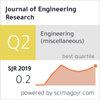Unraveling the role of sintering temperature on physical, structural and tribological characteristics of ball milled Co28Cr6Mo biomaterial based alloy
IF 0.9
4区 工程技术
Q3 ENGINEERING, MULTIDISCIPLINARY
引用次数: 0
Abstract
This work aim to investigate the effect of sintering temperature (950–1250 °C) on structural, physical, tribological properties of nanobiomaterial Co28Cr6Mo alloy for total hip prosthesis obtained by high Energy ball milled. Several techniques such as density, porosity, microhardness, and Young’s modulus were used to assess the mechanical and physical characteristics. Tribological behavior were conducted using a ball-on-plate type Oscillating tribometer, under different applied loads (2, 10 and 20 N), under a wet condition using hank’s solution to simulate human body fluid. SEM, EDS and XRD analysis results, showed that Co-Cr-Mo alloy samples sintered exhibit the same phases created by the Co element. The alloy sintered at 1250 °C displayed the highest micro-hardness value in terms of mechanical characteristics (386.75 HV0.1. The porosity changes from 17% to 10% and endorse a higher change in Young’s modulus around 61.84 and 92.5 GPa for samples sintered beteewn 950 and 1250 °C, respectively,. A remarkable decrease in the wear rate and volume values is obtained for the sample sintered at 1250 °C (32.1610–3 μm3 (N.m)− 1) compared to other samples sintered at 1150 and 1250 °C. Under wet tribological conditions, the abrasive and adhesive wear mechanisms were identified as the main degradation mechanisms for all sintered samples.
揭示烧结温度对球磨 Co28Cr6Mo 生物材料基合金的物理、结构和摩擦学特性的影响
这项工作旨在研究烧结温度(950-1250 °C)对高能球磨获得的用于全髋关节假体的纳米生物材料 Co28Cr6Mo 合金的结构、物理和摩擦学特性的影响。采用密度、孔隙率、微硬度和杨氏模量等多种技术来评估其机械和物理特性。在使用汉克溶液模拟人体体液的湿润条件下,在不同的外加载荷(2、10 和 20 N)下,使用球板式摆动摩擦磨损测试仪进行了摩擦学测试。SEM、EDS 和 XRD 分析结果表明,烧结的 Co-Cr-Mo 合金样品呈现出由 Co 元素产生的相同相。在 1250 °C 下烧结的合金在机械特性方面显示出最高的显微硬度值(386.75 HV0.1)。在 950 ℃ 和 1250 ℃ 下烧结的样品,孔隙率从 17% 变为 10%,杨氏模量的变化也更大,分别约为 61.84 和 92.5 GPa。与其他在 1150 和 1250 °C 下烧结的样品相比,在 1250 °C 下烧结的样品的磨损率和体积值明显降低(32.1610-3 μm3 (N.m)-1)。在湿摩擦学条件下,所有烧结样品的主要降解机制都是磨料磨损和粘着磨损。
本文章由计算机程序翻译,如有差异,请以英文原文为准。
求助全文
约1分钟内获得全文
求助全文
来源期刊

Journal of Engineering Research
ENGINEERING, MULTIDISCIPLINARY-
CiteScore
1.60
自引率
10.00%
发文量
181
审稿时长
20 weeks
期刊介绍:
Journal of Engineering Research (JER) is a international, peer reviewed journal which publishes full length original research papers, reviews, case studies related to all areas of Engineering such as: Civil, Mechanical, Industrial, Electrical, Computer, Chemical, Petroleum, Aerospace, Architectural, Biomedical, Coastal, Environmental, Marine & Ocean, Metallurgical & Materials, software, Surveying, Systems and Manufacturing Engineering. In particular, JER focuses on innovative approaches and methods that contribute to solving the environmental and manufacturing problems, which exist primarily in the Arabian Gulf region and the Middle East countries. Kuwait University used to publish the Journal "Kuwait Journal of Science and Engineering" (ISSN: 1024-8684), which included Science and Engineering articles since 1974. In 2011 the decision was taken to split KJSE into two independent Journals - "Journal of Engineering Research "(JER) and "Kuwait Journal of Science" (KJS).
 求助内容:
求助内容: 应助结果提醒方式:
应助结果提醒方式:


